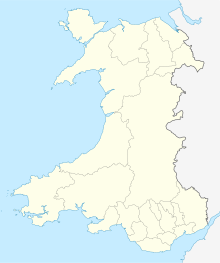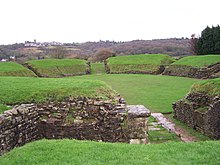Isca Silurum
Coordinates: 51 ° 36 ′ 38.3 " N , 2 ° 57 ′ 19.4" W.
Isca Silurum , also Isca Augusta , located near today's Caerleon , was a Roman legion camp on the British Isles . It is located in southwest Wales at the mouth of the Usk River , 15 kilometers southwest of Venta Silurum ( Caerwent ). The Roman name Isca is derived from the Gaelic name for water.
With an area of 20.5 hectares, Isca Castle is in the middle area when compared to the legionary camps of the imperial era. Strategic reasons probably played a role in choosing the location at the mouth of the Usk. From 74/75 AD Isca was the base of the Legio II Augusta . The place was probably uninhabited prior to the establishment of the camp. Pre-Roman finds or finds that date before 74/75 are not yet known. Coin finds with minting dates up to 370 prove a - possibly only civil - continuity in Caerleon. The final coin is Theodosian (388–395).
During his excavations in the 1920s, Sir Mortimer Wheeler realized that the Roman presence in Caerleon ended in the 3rd century. The 4th century could not be documented outside of the fence until today.
Research history
The ruins of Caerleon, including the bathhouse, were first mentioned in 1188 by Giraldus Cambrensis . Geoffrey of Monmouth identified the ruins of Caerleon as the Camelot of King Arthur . In 1405 a French expedition corps in the service of Owein Glendowyr reported on the remains of the amphitheater . It held the ruin for King Arthur's round table . In the 18th century, travelers and scholars kept digging in the area and found broken pieces, coins and bricks with LEG II AVG stamps . In 1850, John Edward Lee built a museum in which the numerous finds were collected. The funds came from the local citizens. Lee also founded the Caerleon Antiquarian Association, which ran the museum until 1930. Today the Roman Legionary Museum is one of Welsh six national museums.
In 1909 the first archaeological excavations were carried out. Victor Nash-Williams (1897–1955) of the Welsh National Museum began extensive excavations in the barracks in Prysg Field in 1926. Mortimer Wheeler began digging in the amphitheater in 1927, partly with funds from the Daily Mail . Andrew Gardner of University College London has been digging parts of the team barracks since 2007 .
Selected buildings
In Isca Silurum there are three construction phases:
- First phase: 74/75 AD to 122 AD (wood-earth fort)
- Second phase: 122 to 196 AD
- Third phase: 196 to 293 AD
Principia
The principia of the legionary camp were never completed. Your basilica is 64.5 meters long and 25 meters wide. In the archaeological evidence, massive column foundations stand out. However, there are no traces of the actual pillars. Either these never existed or they were built elsewhere after the warehouse was abandoned. The legionary sanctuary ( aedes ) was completed at an early stage.
Contubernia / Centuria
The foundations of the team barracks ( contubernia ) in the western part of the excavated legionary camp are remarkably well preserved . They were excavated by Nash-Williams and partially reconstructed. Each contubernium is about 74 feet long and 11.5 feet wide. Latrines and washrooms are easy to identify. Each individual barrack had space for eight men. The centuria was more spacious and, in addition to the centurio's living room , contained an office.
Valetudinarium
The medical area of the camp ( valetudinarium ) occupies an area of around 70 m². This part has hardly been excavated so far.
Thermal bath
The thermal baths inside the camp were built at an early stage of construction. A coin from this area gives a terminus post quem AD 77–78. The core building measures 47 × 21.5 meters. Each hall ( caldarium , tepidarium , frigidarium ) spans 40 Roman feet (11.8 m). Two construction phases from the Flavian period are documented . In the second phase a basilica was added. The roofed basilica was 64.5 x 24 meters and was connected to the via principalis . It was never completed. Many of the most beautiful finds from Caerleon come from the area of the camp thermal bath, including 88 gems (from rings) from the drain of the frigidarium . Jewelry and milk teeth show that women and children also had access. The bath is partially secured with a protective structure and serves as a museum.
amphitheater
To the west of the camp is the amphitheater . During excavations from 1926 onwards, Victor Nash-Williams was able to determine that the amphitheater was built around 90 AD. It was later rebuilt twice, in the early 2nd century and about a hundred years later. The arena has eight entrances and held about 6000 spectators. The extensive barracks were also uncovered by Nash-Williams and partially reconstructed. The structure has eight entrances and measures 86 × 63 meters. The cardus , the short axis of the theater, is 41.3 meters (140 Roman feet) in length. The estuarine sandy soil in the interior was drained using a drainage system. Tegulae with an Antoniana stamp were installed in the amphitheater . This speaks in favor of a renovation of the complex after AD 213. It was called "King Arthur's Round Table" because of its oval shape.
Warehouse outside area
Vicus Bullmore is located near the legionary camp . The vicus has its own grave field from the 2nd and 3rd centuries. A sarcophagus was found here , which was built with stone slabs from the camp thermal bath.
Extensive square earthworks near Llandrindod , around 90 km from Caerleon, are also assigned to the legionary camp. This may be a maneuvering place.
Monument protection
The area of the camp is a ground monument . Investigations and targeted collection of finds are subject to approval, random finds must be reported to the monument authorities (CADWR).
literature
- George C. Boon: The Legionary Fortress of Caerleon Isca. Roman Legionary Museum, Caerleon 1987. ISBN 0-7200-0316-4
- George C. Boon: Isca (Caerleon) Monmouthshire, S Wales . In: Richard Stillwell et al. a. (Ed.): The Princeton Encyclopedia of Classical Sites. Princeton University Press, Princeton NJ 1976, ISBN 0-691-03542-3 .
- Kai Brodersen : The Roman Britain. Primus, Darmstadt 1998. ISBN 3-89678-080-8
- Donald Moore: Caerleon - Fortress of the Legion. National Museum of Wales , Cardiff 1975, 1979. ISBN 0-7200-0224-9
- L. Murray-Threipland: Caerleon, Museum Street site. in: Archaeologia Cambrensis. Lpndpn 114.1965, pp. 130-145. ISSN 0306-6924
- L. Murray-Threipland: Excavations at Caerleon. in: Archaeologia Cambrensis. London 115.1966. ISSN 0306-6924
- L. Murray-Threipland: Barracks in the north corner, the legionary Fortress, Caerleon. in: Archaeologia Cambrensis. London 116.1967, 23-56. ISSN 0306-6924
- L. Murray-Threipland: The Hall, Caerleon, site of the legionary hospital. in: Archaeologia Cambrensis. London 118.1969, 86-123. ISSN 0306-6924
- VE Nash-Williams: The Roman legionary fortress at Caerleon. Monmouthshire, report on the excavations carried out in the Prysg Field 1927-29. TI in: Archaeologia Cambrensis. London 86.1931, 99-157. ISSN 0306-6924
- VE Nash-Williams: The Roman legionary fortress at Caerleon. T. II. In: Archaeologia Cambrensis. London 87.1932, 48-104. ISSN 0306-6924
- JD Zienkiewicz: The Legionary Fortress Baths at Caerleon. National Museum of Wales, Cardiff 1986. ISBN 0-7200-0304-0
Web links
- Esmonde Cleary, A., DARMC, R. Talbert, S. Vanderbilt, R. Warner, S. Gillies, T. Elliott: Places: 79532 (Isca) . Pleiades. Retrieved February 2, 2013.
- The Caerleon Research Committee
- Community Archeology Forum (CAF) page on Isca Siliurum
- 2008 excavation campaign
- Channel 4 documentary: The Time Team in Romes Wild West
- Cardiff University, Isca: the Roman legionary fortress at Caerleon
- Caerleon / Caerlleon ar Wysg
Individual evidence
- ^ A. Gardner, P. Guest: Fortress Isca . In: Current Archeology , 226, 2009, pp. 31-37; A. Gardner: Soldiers and spaces - Daily life in late Roman forts . In L. Lavan, E. Swift, T. Putzeys (Eds.): Objects in Context, Objects in Use. Material spatiality in late antiquity . EJ Brill, Leiden 2007 (Late Antique Archeology 5), pp. 657-683.





